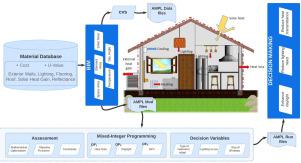当前位置:
X-MOL 学术
›
Energy Rep.
›
论文详情
Our official English website, www.x-mol.net, welcomes your feedback! (Note: you will need to create a separate account there.)
Enhancing the passive design of buildings: A mixed integer non-linear programming approach for the selection of building materials and construction building systems
Energy Reports ( IF 5.2 ) Pub Date : 2021-06-30 , DOI: 10.1016/j.egyr.2021.04.063 Ahmed W.A. Hammad , Karoline Figueiredo , Ana Carolina Rosa , Elaine Vazquez , Assed Haddad
Energy Reports ( IF 5.2 ) Pub Date : 2021-06-30 , DOI: 10.1016/j.egyr.2021.04.063 Ahmed W.A. Hammad , Karoline Figueiredo , Ana Carolina Rosa , Elaine Vazquez , Assed Haddad

|
Consumption of energy in buildings accounts for a considerable proportion of worldwide energy use. There is a dire need for enhancing the energy efficiency of building to limit their demand for operating energy as this leads to enhanced reductions in environmental impacts. Of particular relevance to the amount of energy utilised in a building during the operation phase is the nature of material and size of components utilised in the building. In this work, a mathematical programming framework is presented to optimise a number of building design objective functions, including heat gain, daylight and economic cost of material utilised. The variables that are focussed on in this study are the sizes of windows, type of material adopted for the building, embodied in the construction building systems used for various building components, and the type of lighting adopted. To validate the framework, two realistic case studies obtained from an industry partner are adopted and solved via the use of the proposed mathematical programming method. Results indicate that compared to the solutions proposed by an experienced engineer, the daylight, heating and cost of the building is enhanced by up to 39%, 43% and 23% respectively. The framework is hoped to help policy makers introduce more streamlined guidance for the building sector when it comes to optimised material choice and window sizing to result in energy-efficient and economical buildings.
中文翻译:

增强建筑的被动设计:用于选择建筑材料和建筑系统的混合整数非线性规划方法
建筑物的能源消耗占全球能源使用的相当大的比例。迫切需要提高建筑物的能源效率,以限制其对运行能源的需求,因为这可以进一步减少对环境的影响。与建筑物在运行阶段使用的能源量特别相关的是建筑物中使用的材料的性质和部件的尺寸。在这项工作中,提出了一个数学编程框架来优化许多建筑设计目标函数,包括热量增益、日光和所用材料的经济成本。本研究重点关注的变量是窗户的尺寸、建筑采用的材料类型、各种建筑构件所采用的建筑系统所体现的材料以及采用的照明类型。为了验证该框架,采用了从行业合作伙伴那里获得的两个实际案例研究,并通过使用所提出的数学规划方法进行了解决。结果表明,与经验丰富的工程师提出的解决方案相比,建筑物的日光、供暖和成本分别提高了 39%、43% 和 23%。该框架有望帮助政策制定者在优化材料选择和窗户尺寸方面为建筑行业引入更简化的指导,以实现节能和经济的建筑。
更新日期:2021-06-30
中文翻译:

增强建筑的被动设计:用于选择建筑材料和建筑系统的混合整数非线性规划方法
建筑物的能源消耗占全球能源使用的相当大的比例。迫切需要提高建筑物的能源效率,以限制其对运行能源的需求,因为这可以进一步减少对环境的影响。与建筑物在运行阶段使用的能源量特别相关的是建筑物中使用的材料的性质和部件的尺寸。在这项工作中,提出了一个数学编程框架来优化许多建筑设计目标函数,包括热量增益、日光和所用材料的经济成本。本研究重点关注的变量是窗户的尺寸、建筑采用的材料类型、各种建筑构件所采用的建筑系统所体现的材料以及采用的照明类型。为了验证该框架,采用了从行业合作伙伴那里获得的两个实际案例研究,并通过使用所提出的数学规划方法进行了解决。结果表明,与经验丰富的工程师提出的解决方案相比,建筑物的日光、供暖和成本分别提高了 39%、43% 和 23%。该框架有望帮助政策制定者在优化材料选择和窗户尺寸方面为建筑行业引入更简化的指导,以实现节能和经济的建筑。



























 京公网安备 11010802027423号
京公网安备 11010802027423号